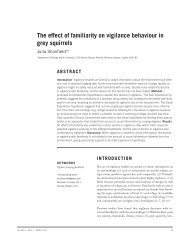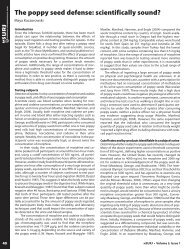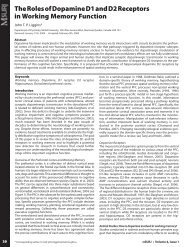the entire issue - McGill Science Undergraduate Research Journal ...
the entire issue - McGill Science Undergraduate Research Journal ...
the entire issue - McGill Science Undergraduate Research Journal ...
Create successful ePaper yourself
Turn your PDF publications into a flip-book with our unique Google optimized e-Paper software.
Proof-carrying authorization in distributed systems with Beluga: a case study<br />
This means if m is evaluated under A in world w to m′ under A′ and<br />
m is of type m in world w <strong>the</strong>n m′ is of type A in world w. This can be<br />
implemented in Beluga using a similar method as <strong>the</strong> previous proof.<br />
The statement of <strong>the</strong> <strong>the</strong>orem is written as follows:<br />
rec thmc11 : [. is_ws M AA W M’ AA’] -><br />
[. is_inwld M A W] -><br />
[. is_inwld M’ A W] =<br />
fn d => fn f => case d of<br />
....<br />
We will not review how to implement each specific case here, as it is<br />
<strong>the</strong> same methodology as <strong>the</strong> preservation cases.<br />
We can represent this in Beluga as:<br />
| [. isinwld_scd D] => let [. R] = thmc4 [.AA] [. D] in<br />
.....<br />
(case [. R] of<br />
| [. r_ws T] => [. r_ws (isws_scd T)]<br />
| [. r_val W AA’ V] =><br />
))<br />
(case [. V] of<br />
| [. isval_xV V1 V2] => [. r_ws (isws_pairscd V)]<br />
The Lemma C.5 that is referred to in <strong>the</strong> derivation analysis is a weakening<br />
lemma. In Beluga, it is not necessary to implement <strong>the</strong> lemma<br />
itself, and it can be implemented directly into <strong>the</strong> function (as can<br />
be seen above in <strong>the</strong> case of r val<br />
). Moreover, it is not necessary to explicitly<br />
mention <strong>the</strong> impossible cases of [. V], <strong>the</strong> value. There is only<br />
one possible way <strong>the</strong> statement can be true under <strong>the</strong> assumptions of<br />
that case and so only that case needs to be expressed.<br />
Moreover, we do not need to represent <strong>the</strong> contexts. They are ei<strong>the</strong>r<br />
constant or can be easily included directly in <strong>the</strong> statement. This removes<br />
a lot of notation in Beluga’s implementation.<br />
Similar translations are done for all <strong>the</strong> possible derivations.<br />
We <strong>the</strong>n continue and implement a proof of preservation in Beluga.<br />
As described in PCML 5<br />
:<br />
Benefits of using Beluga<br />
Following <strong>the</strong> successful implementation of PCML 5<br />
in Beluga, it becomes<br />
clear that Beluga offers an advantageous environment in<br />
which to implement PCML 5<br />
and encode proof-carrying code. The<br />
Beluga framework leads to a comparatively concise encoding of both<br />
<strong>the</strong> authorization logic and <strong>the</strong> <strong>the</strong>orems laid out in <strong>the</strong> PCML 5<br />
paper.<br />
One factor leading to this concise representation is <strong>the</strong> elimination<br />
of <strong>the</strong> need to repeatedly represent <strong>the</strong> contexts. It was unnecessary<br />
to encode impossible or irrelevant cases, cutting down greatly on <strong>the</strong><br />
amount of notation.<br />
Moreover, PCML 5<br />
required an implementation of separate lemmas for<br />
inversion, weakening, canonical forms, substitution or renaming. In<br />
Beluga however, <strong>the</strong>se are ei<strong>the</strong>r automatic or could be encoded directly<br />
in <strong>the</strong> function.<br />
To get a more concrete idea of how much more concise PCML 5<br />
is<br />
when implemented in Beluga, consider <strong>the</strong> exact amount of code<br />
needed. There is no way to save space when implementing <strong>the</strong> primitive<br />
types of PCML 5<br />
’s authorization logic in Beluga; each primitive<br />
type takes one line to encode. However, since in most cases we do<br />
not need to encode <strong>the</strong> contexts, we save a lot of symbolism when<br />
using Beluga to write out <strong>the</strong> inference rules and <strong>the</strong> <strong>the</strong>orems. The<br />
inference rules each take one line in Beluga. Due to <strong>the</strong> fact that we<br />
do not need to implement supplementary lemmas in order to successfully<br />
prove <strong>the</strong> progress and preservation <strong>the</strong>orems in Beluga,<br />
60<br />
<strong>McGill</strong> <strong>Science</strong> <strong>Undergraduate</strong> <strong>Research</strong> <strong>Journal</strong> - msurj.mcgill.ca









